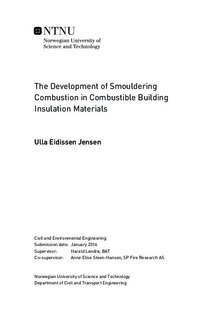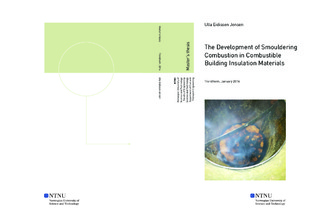| dc.description.abstract | Energy wastage due to little or bad thermal insulation is a problem. An increase in the quality of the building envelope with more and better insulation is therefore an initiative to reduce the emission of greenhouse gases. Smouldering fire is a hazard in combustible insulation. A material can decompose and undergo a smouldering combustion at lower temperatures than needed to initiate a flaming fire, and cellulose insulation in combination with inadequate separation from electrical appliances and heat-producing equipment has led to smouldering combustions and building fires. The purpose of this thesis was to find the conditions necessary for combustible building insulation materials to undergo a self-sustained smouldering combustion. The main goal was to find the temperature exposure needed to initiate a self-sustained smouldering combustion. If smouldering was obtained, the differences and similarities in the combustion of the different test materials was studied and connected to the chemical and physical properties of the materials. The thesis is based on experimental tests. A literature study was used as a foundation for the discussion of test results. Four different types wood fibre insulation was tested. The samples were placed in an insulated steel chimney above a hotplate, and heated from underneath. Temperature development and mass loss was registered during the testing. The results show that one of the four test materials obtained a smouldering combustion at temperatures much lower than the rest. Two different types of smouldering behaviours were observed in the test samples. The distinction was made based on the registered mass losses and maximum temperatures. The one with highest maximum temperature and mass loss was found to be typical for materials undergoing a secondary oxidation of the char. The temperatures needed from external heating to obtain a self-sustained smouldering behaviour in the tested materials are: 275 °C for material T, 280 °C for material U, 225 °C for material V and 290 °C for material W. This indicated that an onset of a self-sustained smouldering combustion occurs at lower temperature in insulation material with smaller fibre size than in a material with larger fibre size, when the materials have the same added level of fire retardant. A higher level of added fire retardant gave an onset of a smouldering combustion at lower temperatures, when the fibre size of the material is the same. The testing and results in this thesis is only indicative. Future work should include more tests with each material, but narrow down the factors to be studied. The existing test results can also be analysed with other methods than the ones used in this thesis, to look for more information. | |

